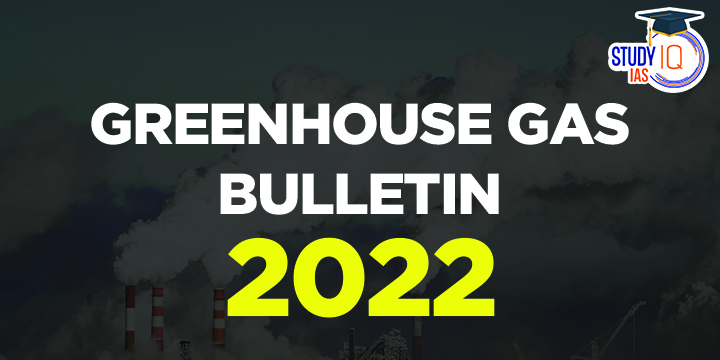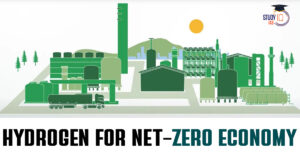Table of Contents
Greenhouse Gas Bulletin Report
Greenhouse Gas Bulletin Report shows the average surface mole fractions for carbon dioxide (CO2), methane (CH4) and nitrous oxide (N2O) and compares them with the mole fractions during the previous year and with the preindustrial levels.
Greenhouse Gas Bulletin 2022 also provides change in radiative forcing by long-lived GHGs (LLGHGs) and the contribution of individual gases to this increase.
Greenhouse Gas Bulletin Highlights
- Atmospheric levels of the three main greenhouse gases – carbon dioxide, methane and nitrous oxide have reached new record highs in 2022.
- The biggest year-on-year jump was observed in methane concentrations in both 2020 and 2021 since systematic measurements began nearly 40 years ago.

| Greenhouse Gas | Details |
| Carbon Dioxide (CO2) | Concentration: Atmospheric carbon dioxide concentration has reached 149% of the pre-industrial level in 2021. It was majorly due to emissions from the combustion of fossil fuels and cement production.
CO2 is responsible for about 81% of the increase in radiative forcing over the past decade and about 80% of the increase over the last five years. Accumulation: Out of the total emissions released from human activities during the 2011–2020 period, about 48% accumulated in the atmosphere, 26% in the ocean and 29% on land. Effects: In future, the ability of lands and oceans to become carbon sinks will be affected and as a result, they will start becoming source of CO2 emission. |
| Methane (CH4) | Impact: The second largest contributor to climate change is atmospheric methane. It consists of a diverse mix of overlapping sources and sinks.
Source: The largest contribution to the renewed increase in methane since 2007 is a result of biogenic sources, such as wetlands or rice paddies. Anthropogenic sources at the mid-latitudes of the northern hemisphere are also a major reason for increase. Feedback effect: It is assumed that increased methane creates a feedback effect that includes faster decomposition of organic matter, resulting in further methane emissions. Climate event: Climatic events such as La Niña events increase precipitation in the tropics, which are associated with increase in methane emissions. |
| Nitrous Oxide (N2O) | Concentration: Nitrous Oxide is the third largest greenhouse gas emitted into the atmosphere from both natural sources (approximately 57%) and anthropogenic sources (approximately 43%).
The increase in NO2 emissions from 2020 to 2021 was slightly higher than that observed from 2019 to 2020. Source: Global human-induced N2O emissions are dominated by nitrogen additions to croplands. It has increased by 30% over the past four decades. This increase in emission was mainly responsible for the growth in the atmospheric burden of N2O. |
| Other Greenhouse Gases | While CFCs and most halons are decreasing, some hydrochlorofluorocarbons (HCFCs) and hydrofluorocarbons (HFCs) are increasing at faster rates.
Sulfur hexafluoride (SF6) is an extremely potent greenhouse gas and is produced by the chemical industry, mainly as an electrical insulator in power distribution equipment. Smaller compounds such as carbon monoxide, nitrogen oxides and volatile organic compounds, although not considered as greenhouse gases, have small direct or indirect effects on radiative forcing. Aerosols (suspended particulate matter) are short-lived compounds/matter that can alter the radiation budget. |
Greenhouse Gas Bulletin 2022: Radiative Forcing:
- Radiative forcing is a condition that occurs when the amount of energy that enters the Earth’s atmosphere is different from the amount of energy that leaves it.
- The concept is used to quantify and compare the external drivers of change to Earth’s energy balance.
- Positive radiative forcing: It means Earth receives more incoming energy from sunlight than it radiates to space. This net gain of energy from radiation will cause warming.
- Negative radiative forcing: it means that Earth loses more energy to space than it receives from the sun, which produces cooling.

Greenhouse Gas Bulletin WMO
- WMO is a specialised UN agency whose mandate covers weather, climate and water resources. WMO originated from the International Meteorological Organization (IMO).
- The Geneva-headquartered agency is headed by the Secretary-General. The World Meteorological Congress is its supreme body.


 Hydrogen For Net-Zero Economy, Governmen...
Hydrogen For Net-Zero Economy, Governmen...
 Mantis Shrimp - Latest Research News and...
Mantis Shrimp - Latest Research News and...
 IB ACIO Syllabus 2025, Subject-Wise Exam...
IB ACIO Syllabus 2025, Subject-Wise Exam...





















